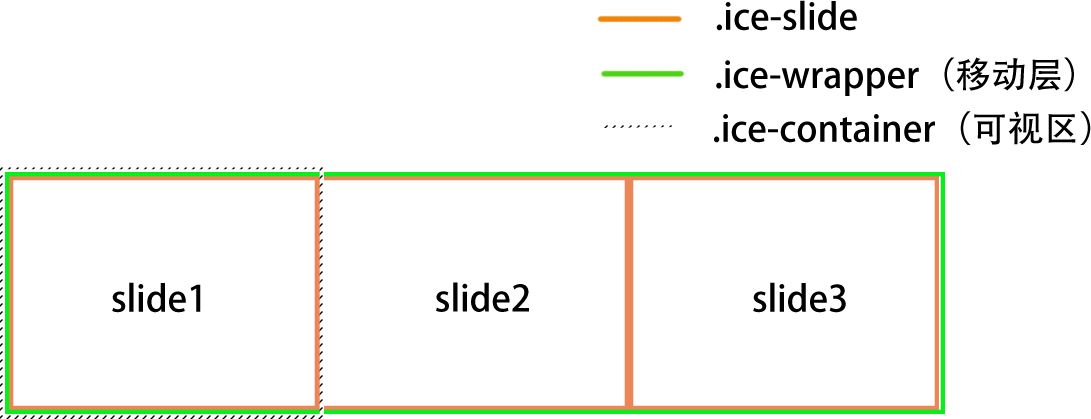前言
移动端,滑动是很常见的需求。很多同学都用过swiper.js,本文从原理出发,实践出一个类swiper的滑动小插件ice-skating。
小插件的例子:
在写代码的过程中产生的一些思考:
- 滑动的原理是什么
- 怎么判断动画完成
- 事件绑定到哪个元素,可否使用事件委托优化
- pc端和移动端滑动有何不同
- 正在进行的动画触摸时怎么取得当前样式
- 如何实现轮播
基本原理
滑动就是用transform: translate(x,y)或者transform: translate3d(x,y,z)去控制元素的移动,在松手的时候判定元素最后的位置,元素的样式应用transform: translate3d(endx , endy, 0)和transition-duration: time来达到一个动画恢复的效果。标准浏览器提供transitionend事件监听动画结束,在结束时将动画时间归零。
Note: 这里不讨论非标准浏览器的实现,对于不支持transform和transition的浏览器,可以使用position: absolute配合left和top进行移动,然后用基于时间的动画的算法来模拟动画效果。
html结构
举例一个基本的结构:
//example
<div class="ice-container">
<div class="ice-wrapper" id="myIceId">
<div class="ice-slide">Slide 1</div>
<div class="ice-slide">Slide 2</div>
<div class="ice-slide">Slide 3</div>
</div>
</div>transform: translate3d(x,y,z)就是应用在className为ice-slide的元素上。这里不展示css代码,可以在ice-skating的example文件中里查看完整的css。css代码并不是唯一的,简单说只要实现下图的结构就可以。

从图中可以直观的看出,移动的是绿色的元素。className为ice-slide的元素的宽乘于当前索引(offsetWidth * index),就是每次稳定时的偏移量。例如最开始transform: translate3d(offsetWidth * 0, 0, 0),切换到slide2后,transform: translate3d(offsetWidth * 1, 0, 0),大致就是这样的过程。
实践
源码位于ice-skating的dist/iceSkating.js。我给插件起名叫ice-skating,希望它像在冰面一样顺畅^_^
兼容各模块标准的容器
以前我们会将代码包裹在一个简单的匿名函数里,现在需要加一些额外的代码来兼容各种模块标准。
(function (global, factory) {
typeof exports === 'object' && typeof module !== 'undefined' ? factory(exports) :
typeof define === 'function' && define.amd ? define(['exports'], factory) :
(factory((global)));
}(this, (function (exports) {
'use strict';
})));状态容器
用两个对象来存储信息
- 一个页面可以实例化很多滑动对象,mainStore存储的是每个对象的信息,比如宽高,配置参数之类的。
- state存储的是触摸之类的临时信息,每次触摸后都会清空。
var mainStore = Object.create(null);
var state = Object.create(null);Object.create(null)创建的对象不会带有Object.prototype上的方法,因为我们不需要它们,例如toString、valueOf、hasOwnProperty之类的。
构造函数
function iceSkating(option){
if (!(this instanceof iceSkating)) return new iceSkating(option);
}
iceSkating.prototype = {
}if (!(this instanceof iceSkating)) return new iceSkating(option);很多库和框架都有这句,简单说就是不用new生成也可以生成实例。
触摸事件
对于触摸事件,在移动端,我们会用touchEvent,在pc端,我们则用mouseEvent。所以我们需要检测支持什么事件。
iceSkating.prototype = {
support: {
touch: (function(){
return !!(('ontouchstart' in window) || window.DocumentTouch && document instanceof DocumentTouch);
})()
}支持touch则认为是移动端,否则为pc端
var events = ic.support.touch ? ['touchstart', 'touchmove', 'touchend']:['mousedown','mousemove','mouseup'];声明事件函数
pc端和移动端这3个函数是通用的。
var touchStart = function(e){};
var touchMove = function(e){};
var touchEnd = function(e){};初始化事件
var ic = this;
var initEvent = function(){
var events = ic.support.touch ? ['touchstart', 'touchmove', 'touchend']: ['mousedown','mousemove','mouseup'];
var transitionEndEvents = ['webkitTransitionEnd', 'transitionend', 'oTransitionEnd', 'MSTransitionEnd', 'msTransitionEnd'];
for (var i = 0; i < transitionEndEvents.length; i++) {
ic.addEvent(container, transitionEndEvents[i], transitionDurationEndFn, false);
}
ic.addEvent(container, events[0], touchStart, false);
//默认阻止容器元素的click事件
if(ic.store.preventClicks) ic.addEvent(container, 'click', ic.preventClicks, false);
if(!isInit){
ic.addEvent(document, events[1], touchMove, false);
ic.addEvent(document, events[2], touchEnd, false);
isInit = true;
}
};touchStart和transitionDurationEndFn函数每个实例的容器都会绑定,但是所有实例共用touchMove和touchEnd函数,它们只绑定在document,并且只会绑定一次。使用事件委托有两个好处:
- 减少了元素绑定的事件数,提高了性能。
- 如果将
touchMove和touchEnd也绑定在容器元素上,当鼠标移出容器元素时,我们会“失去控制”。在document上意味着可以“掌控全局”。
过程分析
不会把封装的函数的代码都一一列出来,但会说明它的作用。
触碰瞬间
touchStart函数:
会在触碰的第一时间调用,基本都在初始化state的信息
var touchStart = function(e){
//mouse事件会提供which值, e.which为3时表示按下鼠标右键,鼠标右键会触发mouseup,但右键不允许移动滑块
if (!ic.support.touch && 'which' in e && e.which === 3) return;
//获取起始坐标。TouchEvent使用e.targetTouches[0].pageX,MouseEvent使用e.pageX。
state.startX = e.type === 'touchstart' ? e.targetTouches[0].pageX : e.pageX;
state.startY = e.type === 'touchstart' ? e.targetTouches[0].pageY : e.pageY;
//时间戳
state.startTime = e.timeStamp;
//绑定事件的元素
state.currentTarget = e.currentTarget;
state.id = e.currentTarget.id;
//触发事件的元素
state.target = e.target;
//获取当前滑块的参数信息
state.currStore = mainStore[e.currentTarget.id];
//state的touchStart 、touchMove、touchEnd代表是否进入该函数
state.touchEnd = state.touchMove = false;
state.touchStart = true;
//表示滑块移动的距离
state.diffX = state.diffY = 0;
//动画运行时的坐标与动画运行前的坐标差值
state.animatingX = state.animatingY = 0;
};移动
在移动滑块时,可能滑块正在动画中,这是需要考虑一种特殊情况。滑块的移动应该依据现在的位置计算。
如何知道动画运行中的信息呢,可以使用window.getComputedStyle(element, [pseudoElt]),它返回的样式是一个实时的CSSStyleDeclaration 对象。用它取transform的值会返回一个 2D 变换矩阵,像这样matrix(1, 0, 0, 1, -414.001, 0),最后两位就是x,y值。
简单封装一下,就可以取得当前动画translate的x,y值了。
var getTranslate = function(el){
var curStyle = window.getComputedStyle(el);
var curTransform = curStyle.transform || curStyle.webkitTransform;
var x,y; x = y = 0;
curTransform = curTransform.split(', ');
if (curTransform.length === 6) {
x = parseInt(curTransform[4], 10);
y = parseInt(curTransform[5], 10);
}
return {'x': x,'y': y};
};touchMove函数:
移动时会持续调用,如果只是点击操作,不会触发touchMove。
var touchMove = function(e){
// 1. 如果当前触发touchMove的元素和触发touchStart的元素不一致,不允许滑动。
// 2. 执行touchMove时,需保证touchStart已执行,且touchEnd未执行。
if(e.target !== state.target || state.touchEnd || !state.touchStart) return;
state.touchMove = true;
//取得当前坐标
var currentX = e.type === 'touchmove' ? e.targetTouches[0].pageX : e.pageX;
var currentY = e.type === 'touchmove' ? e.targetTouches[0].pageY : e.pageY;
var currStore = state.currStore;
//触摸时如果动画正在运行
if(currStore.animating){
// 取得当前元素translate的信息
var animationTranslate = getTranslate(state.currentTarget);
//计算动画的偏移量,currStore.translateX和currStore.translateY表示的是滑块最近一次稳定时的translate值
state.animatingX = animationTranslate.x - currStore.translateX;
state.animatingY = animationTranslate.y - currStore.translateY;
currStore.animating = false;
//移除动画时间
removeTransitionDuration(currStore.container);
}
//如果轮播进行中,将定时器清除
if(currStore.autoPlayID !== null){
clearTimeout(currStore.autoPlayID);
currStore.autoPlayID = null;
}
//判断移动方向是水平还是垂直
if(currStore.direction === 'x'){
//currStore.touchRatio是移动系数
state.diffX = Math.round((currentX - state.startX) * currStore.touchRatio);
//移动元素
translate(currStore.container, state.animatingX + state.diffX + state.currStore.translateX, 0, 0);
}else{
state.diffY = Math.round((currentY - state.startY) * state.currStore.touchRatio);
translate(currStore.container, 0, state.animatingY + state.diffY + state.currStore.translateY, 0);
}
};translate函数:
如果支持translate3d,会优先使用它,translate3d会提供硬件加速。有兴趣可以看看这篇blog两张图解释CSS动画的性能
var translate = function(ele, x, y, z){
if (ic.support.transforms3d){
transform(ele, 'translate3d(' + x + 'px, ' + y + 'px, ' + z + 'px)');
} else {
transform(ele, 'translate(' + x + 'px, ' + y + 'px)');
}
};触摸结束
touchEnd函数:
在触摸结束时调用。
var touchEnd = function(e){
state.touchEnd = true;
if(!state.touchStart) return;
var fastClick ;
var currStore = state.currStore;
//如果整个触摸过程时间小于fastClickTime,会认为此次操作是点击。但默认是屏蔽了容器的click事件的,所以提供一个clickCallback参数,会在点击操作时调用。
if(fastClick = (e.timeStamp - state.startTime) < currStore.fastClickTime && !state.touchMove && typeof currStore.clickCallback === 'function'){
currStore.clickCallback();
}
if(!state.touchMove) return;
//如果移动距离没达到切换页的临界值,则让它恢复到最近的一次稳定状态
if(fastClick || (Math.abs(state.diffX) < currStore.limitDisX && Math.abs(state.diffY) < currStore.limitDisY)){
//在transitionend事件绑定的函数中判定是否重启轮播,但是如果transform前后两次的值一样时,不会触发transitionend事件,所以在这里判定是否重启轮播
if(state.diffX === 0 && state.diffY === 0 && currStore.autoPlay) autoPlay(currStore);
//恢复到最近的一次稳定状态
recover(currStore, currStore.translateX, currStore.translateY, 0);
}else{
//位移满足切换
if(state.diffX > 0 || state.diffY > 0) {
//切换到上一个滑块
moveTo(currStore, currStore.index - 1);
}else{
//切换到下一个滑块
moveTo(currStore, currStore.index + 1);
}
}
};transitionDurationEndFn函数:
动画执行完成后调用
var transitionDurationEndFn = function(){
//将动画状态设置为false
ic.store.animating = false;
//执行自定义的iceEndCallBack函数
if(typeof ic.store.iceEndCallBack === 'function') ic.store.iceEndCallBack();
//将动画时间归零
transitionDuration(container, 0);
//清空state
if(ic.store.id === state.id) state = Object.create(null);
};至此,一个完整的滑动过程结束。
实现轮播
第一时间想到的是使用setInterval或者递归setTimeout实现轮播,但这样做并不优雅。
事件循环(EventLoop)中setTimeout或setInterval会放入macrotask 队列中,里面的函数会放入microtask,当这个macrotask 执行结束后所有可用的 microtask将会在同一个事件循环中执行。
我们极端的假设setInterval设定为200ms,动画时间设为1000ms。每隔200ms, macrotask 队列中就会插入setInterval,但我们的动画此时没有完成,所以用setInterval或者递归setTimeout的轮播在这种情况下是有问题的。
最佳思路是在每次动画结束后再将轮播开启。
//动画结束执行的函数:
var transitionDurationEndFn = function(){
...
//检测是否开启轮播
if(ic.store.autoPlay) autoPlay(ic.store);
};轮播函数也相当简单
var autoPlay = function(store){
store.autoPlayID = setTimeout(function(){
//当前滑块的索引
var index = store.index;
++index;
//到最后一个了,重置为0
if(index === store.childLength){
index = 0;
}
//移动
moveTo(store, index);
},store.autoplayDelay);
};小结
本文记录了我思考的过程,代码应该还有很多地方值得完善。